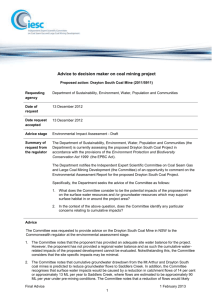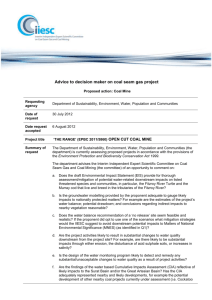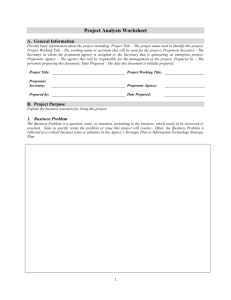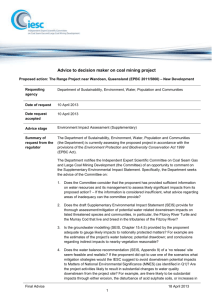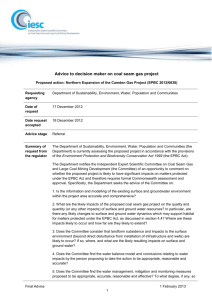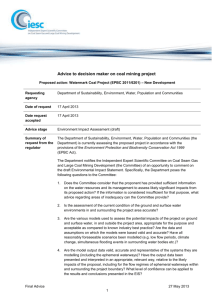Wallarah 2 Coal Project advice (DOCX - 106.92 KB)
advertisement
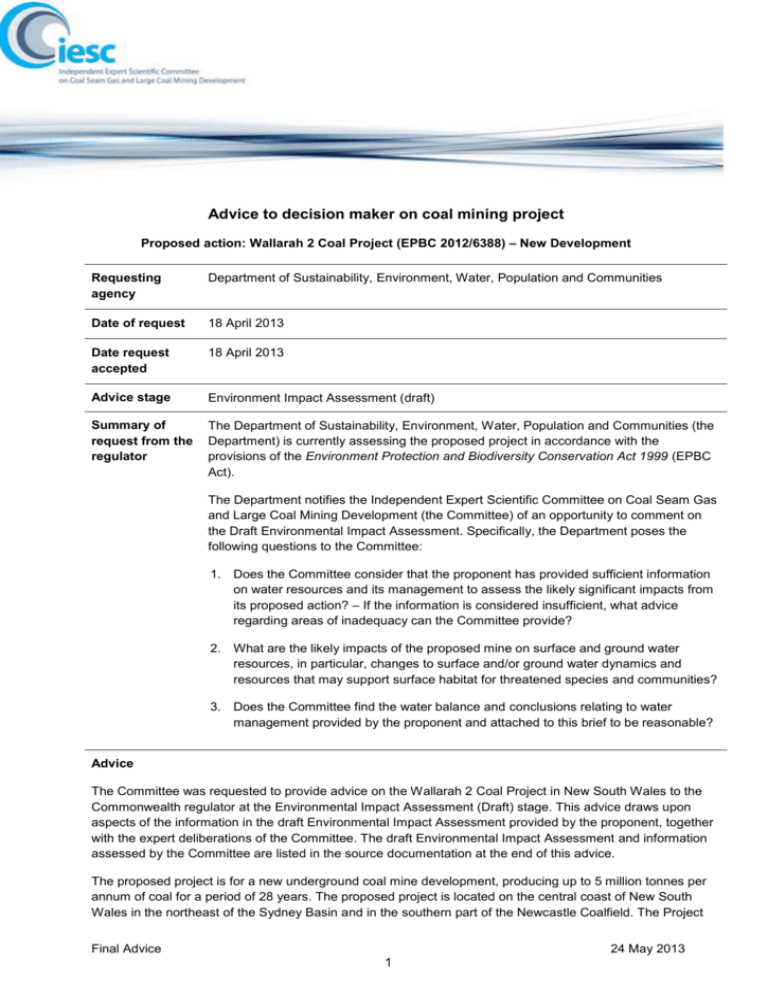
Advi Advice to decision maker on coal mining project Proposed action: Wallarah 2 Coal Project (EPBC 2012/6388) – New Development Requesting agency Department of Sustainability, Environment, Water, Population and Communities Date of request 18 April 2013 Date request accepted 18 April 2013 Advice stage Environment Impact Assessment (draft) Summary of request from the regulator The Department of Sustainability, Environment, Water, Population and Communities (the Department) is currently assessing the proposed project in accordance with the provisions of the Environment Protection and Biodiversity Conservation Act 1999 (EPBC Act). The Department notifies the Independent Expert Scientific Committee on Coal Seam Gas and Large Coal Mining Development (the Committee) of an opportunity to comment on the Draft Environmental Impact Assessment. Specifically, the Department poses the following questions to the Committee: 1. Does the Committee consider that the proponent has provided sufficient information on water resources and its management to assess the likely significant impacts from its proposed action? – If the information is considered insufficient, what advice regarding areas of inadequacy can the Committee provide? 2. What are the likely impacts of the proposed mine on surface and ground water resources, in particular, changes to surface and/or ground water dynamics and resources that may support surface habitat for threatened species and communities? 3. Does the Committee find the water balance and conclusions relating to water management provided by the proponent and attached to this brief to be reasonable? Advice The Committee was requested to provide advice on the Wallarah 2 Coal Project in New South Wales to the Commonwealth regulator at the Environmental Impact Assessment (Draft) stage. This advice draws upon aspects of the information in the draft Environmental Impact Assessment provided by the proponent, together with the expert deliberations of the Committee. The draft Environmental Impact Assessment and information assessed by the Committee are listed in the source documentation at the end of this advice. The proposed project is for a new underground coal mine development, producing up to 5 million tonnes per annum of coal for a period of 28 years. The proposed project is located on the central coast of New South Wales in the northeast of the Sydney Basin and in the southern part of the Newcastle Coalfield. The Project Final Advice 24 May 2013 1 area lies 4.7 km to the southeast of the township of Wyong. Mining will take place between 350 m and 690 m below the surface targeting the Wallarah and Great Northern Coal Seams by means of 46 underground longwalls in an area of 37 km². The Committee, in line with its Information Guidelines1, has considered whether the proposed project assessment has used the following: Relevant data and information: key conclusions Information provided addresses many of the key areas in the Information Guidelines1 however, relevant data and information has not been provided on the following: the risks associated with potential reduction of surface runoff caused by subsidence and the adverse affects on the Gosford-Wyong Water Supply Scheme; the fracture potential of the strata between the targeted coal seam and the surface; changes to the regional water balance; the potential impacts of the project on aquatic ecology; and cumulative impacts associated with current and future mines within the area. Appropriate methodologies which have been applied correctly: key conclusions The key methodologies and assessments needed to fully assess the proposed project that have not been provided include: a regional water balance, that gives particular consideration to both surface and groundwater impacts to the Gosford-Wyong Water Supply Scheme; assessment of subsidence issues associated with longwall mining, relating to the changing of catchment characteristics, variation in groundwater aquifers and potential increased surface water and aquifer interconnectivity; a comprehensive risk assessment of the impacts of the proposed project on surface water and groundwater dependent ecosystems; and a cumulative impact assessment associated with creek systems flowing from the Mandalong Southern Extension Project directly through the proposed extraction site. Reasonable values and parameters in calculations: key conclusions The draft Environmental Impact Assessment generally uses reasonable values and parameters in calculations, with the exception of the use of data from Wallarah Creek in the water balance and the discussion on water quality. The monitoring point located outside the proposed main extraction site may not be an appropriate calibration tool for the site water balance. A lack of supporting information on flood events and impacts on aquatic ecology has also limited the onsite assessments. The proponent has relied heavily on literature reviews to provide analysis and assessments. Question 1: Does the Committee consider that the proponent has provided sufficient information on water resources and its management to assess the likely significant impacts from its proposed action? – If the information is considered insufficient, what advice regarding areas of inadequacy can the Committee provide? 1. The Committee considers that while the proponent has provided water resources and management information, there is limited information on the full suite of groundwater impacts; risks to the regional water balance; subsidence-related impacts; impacts on aquatic ecology; and the project’s risk to the GosfordWyong Water Supply Scheme. Question 2: What are the likely impacts of the proposed mine on surface and ground water resources, in particular, changes to surface and/or ground water dynamics and resources that may support surface habitat Final Advice 24 May 2013 2 for threatened species and communities? 2. The Committee advises that there are significant risks associated with the proposed project having a detrimental and long-lasting effect on an already stressed water supply catchment. The proposal is located within the Jilliby Jilliby Creek Catchment, a major water source for the Gosford-Wyong Water Supply Scheme, which provides water to 285,000 people within the central coast of New South Wales. The proposal has the potential to significantly reduce surface runoff, with the project area covering 5% of the entire scheme’s catchment area. 3. The proposal has the potential to change surface and groundwater dynamics within the Jilliby Jilliby Creek Catchment through subsidence-related impacts. This includes the following: a. Subsidence can lead to increased drainage between aquifers, altering water table heights, flow rates and water quality. Groundwater dependent ecosystems, which rely on shallow water tables, have been identified along surface drainage channels within the project boundary. Regular monitoring of the water table in these areas is needed to ensure that any variation in level can be resolved by remediation measures; b. The predicted subsidence has the potential to alter flooding regimes, causing localised ponding/damming of catchment runoff waters. This has the potential to cause change in depth of water bodies leading to inundation or water logging of emergent or marginal/riparian vegetation, and causing aquatic habitat alteration due to draining or additional deepening of existing ponds, wetlands or dams; c. The proponent has indicated that fracturing as a result of subsidence will extend upwards to a maximum of 200 m from the coal seam. The potential impact caused by fracturing through the entire strata would have detrimental effects, including the reduction of surface flow and draining of shallow aquifers, on which groundwater dependant ecosystems depend. Findings need to be based on both localised modelling, and within a regional context through robust analysis of similar projects in the area, and; d. The forested hill areas of the proposed project are susceptible to surface deformation and cracking due to subsidence. This has the potential to destabilise soils and sediments and mobilise these into creeks and streams increasing sediment loads and nutrient loads. It is noted that the proponent will prepare an Erosion and Sediment Control Plan. It is recommended that this plan address these issues, with specific attention given to the potential impact on the Gosford-Wyong Water Supply Scheme. 4. The proposal indicates that brine and salt concentrate could potentially be stored below ground within the extracted coal seam. Monitoring of groundwater quality, particularly in relation to the storage of salt concentrate, along with mitigation measures, would be required to ensure water quality is not degraded. Contamination of the regional groundwater supply could have severe ramifications for the water quality of the Gosford-Wyong Water Supply Scheme. Due to the potential risk involved, a rigorous groundwater monitoring system is needed to identify and then mitigate any impacts. 5. It is recommended that the proponent develop a post-mine management plan to reduce the impacts on water resources from continued depressurisation after mining. The predicted continued depressurisation 500 years after cessation is likely to impact the surrounding water extraction sources by creating a groundwater sink, having the potential to impact on existing groundwater bores and to contribute to cumulative impacts with surrounding mines. 6. There is insufficient evidence to support the proponent’s conclusion of negligible cumulative impacts. In particular, the potential cumulative impacts brought about by the potential Mandalong Southern Extension Project are likely to have impacts within the Jilliby Jilliby Creek Catchment. It is recommended that an assessment of cumulative groundwater and surface water impacts be undertaken, incorporating where possible current and future mining and other extractive industries. 7. The proponent’s assessments regarding the extent of aquifer connectivity are not justified by the data Final Advice 24 May 2013 3 provided in the project assessment documentation. To increase confidence in the proponent’s assessment of aquifer connectivity, further data collection or validation is needed, both from within the extraction area and at a regional level. 8. The proposed project area includes both threatened and vulnerable flora and fauna species listed under the EPBC Act. The proposal could directly impact populations of EPBC Act listed water dependent species present or potentially present within the proposed project boundary, specifically: two fish species – Australian Grayling (Prototroctes maraena) and the Macquarie perch (Macquaria australasica); four frog species – Littlejohn’s Tree Frog (Litoria littlejohni), the Stuttering Frog (Mixophyes balbus), the Giant Barred Frog (Dasyurus maculates maculates) and the Green and Golden Bell Frog (Litoria aurea), and; one groundwater dependent ecosystem – Biconvex Paperbark [paperbark swamp] (Melaleuca biconvex). The proposal may also directly impact the existing populations of New South Wales Threatened Species Conservation Act 1995 listed water dependent species present or potentially present within the proposed project boundary, specifically: the Wallum Froglet (Crinia tinnula), and; two dragonfly species – the Adams emerald dragonfly (Archaeophya adamsi) and the Giant dragonfly (Petalura gigantean). It is noted that an ecological monitoring program will be established as a component of the Biodiversity Management Plan. This plan is designed to monitor the ongoing status and health of flora and fauna communities that will be retained within the project boundary. It is recommended that the Biodiversity Management Plan specify what mitigation measures are in place for the protection of EPBC Act listed species. Question 3: Does the Committee find the water balance and conclusions relating to water management provided by the proponent and attached to this brief to be reasonable? 9. A regional water balance, which is considered essential to appropriately assess the regional cumulative impacts and risks to the Gosford-Wyong Water Supply Scheme, has not been provided. 10. The proponent has not considered the potential impacts on the surrounding creeks and water quality as a result of uncontrolled discharge from the mine operations dams. The mine operation dams are currently designed to contain a 100 year average recurrence interval 72 hour storm event. Consideration should be given to mine operation dams being redesigned to contain a larger storm event (1 in 1000 year average recurrence interval) to minimise the potential for downstream water quality and ecological impacts. 11. Further assessment is recommended to gauge the extent of water interaction within the extraction boundary. The proponent has assessed the calibration of the runoff model using a gauging station on the Wallarah Creek. It is noted that the station only operated from 1965 to 1976 and is not located within the main project area. This dataset provides limited confidence in the calibration of the surface water balance. 12. The proponent has stated that a water treatment plant will treat mine water to a quality that is similar to the existing Wallarah Creek water quality values, before being discharged into the creek system. Further clarification is needed on what the proponent specifies as ‘existing water quality values’ proposed for treated water released into the Wallarah Creek. All site and surface water plans should be constructed in accordance with the National Water Quality Management Strategy². 13. The release of controlled treated mine water is likely to occur when there is no natural flow in Wallarah Creek, and these releases have the potential to change flow regimes of the creek. The proponent has stated that Wallarah Creek will remain ephemeral in nature, after water releases have been made. It is Final Advice 24 May 2013 4 recommended that mitigation measures are put in place to conserve the natural flow characteristics of the Wallarah Creek. 14. The proponent has entitlements to extract water from both surface and groundwater sources within the proposed extraction area. The proposed project requires external water to make up the deficit. The proponent has advised that this will be done through town water supplies with relevant licences still to be obtained. It is suggested that an assessment be made on the potential impacts of extracting water from town sources during extreme weather periods including drought conditions. 15. The Northern Sydney Basin has been identified as a Bioregional Assessment priority region. Data and relevant information from the proposed project should be made accessible for this Bioregional Assessment to assist the knowledge base for regional scale assessments. Date of advice 24 May 2013 Source documentation available to the Committee in the formulation of this advice Hansen Bailey 2013. Wallarah 2 Coal Project, Environmental Impact Statement. Prepared for Wyong Areas Coal Joint Venture. February 2013 References cited within the Committee’s advice 1 Information Guidelines for Proposals Relating to the Development of Coal Seam Gas and Large Coal Mines where there is a Significant Impact on Water Resources available at: http://www.environment.gov.au/coal-seam-gas-mining/project-advice/pubs/iescinformation-guidelines.pdf ² Australian and New Zealand Guidelines for Fresh and Marine Water Quality. National Water Quality Management Strategy (NWQMS). Volume 4. Australian and New Zealand Environment and Conservation Council & Agriculture and Resource Management Council for Australia and New Zealand. Canberra. Final Advice 24 May 2013 5
